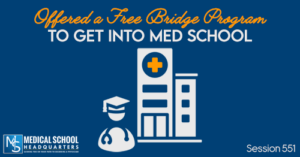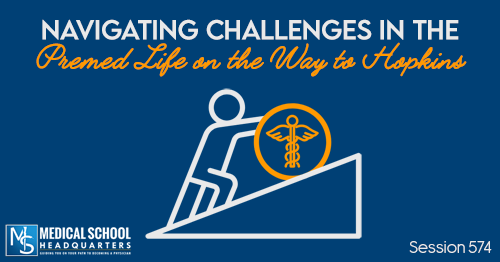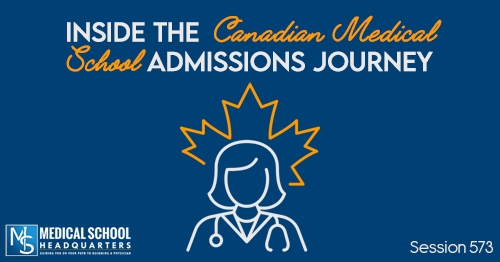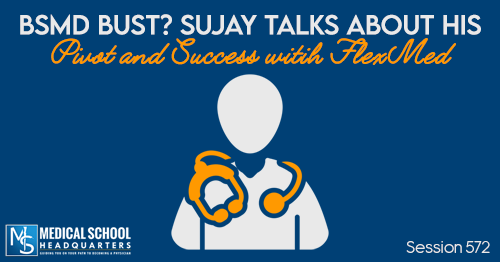Apple Podcasts | Google Podcasts
Session 551
Liz was able to secure medical school acceptance in her first application cycle by sharing her story and applying to schools that matched her goals.
For more podcast resources to help you with your medical school journey and beyond, check out Meded Media.
Listen to this podcast episode with the player above, or keep reading for the highlights and takeaway points.
Her Interest in Becoming a Physician
Liz realized she wanted to be a doctor when she was around 5 years old. She remembers her mom used to put her in front of the medical drama ER on TV. Even as a young child, she found it fascinating to see how doctors were able to help people who were seriously injured or ill. This sparked her interest in medicine from an early age.
Liz mentioned that as a child she had chronic asthma, and was always in and out of the hospital because of it. This gave her some level of comfort and familiarity with being in the hospital environment. She enjoyed asking doctors questions when she was being treated.
Having asthma and experiencing being a patient helped her relate to what she saw on medical shows like ER. Even though her conditions were never as serious as the trauma cases depicted. It helped her connect her own experiences of being cared for by physicians to what she was interested in learning more about.
Nurturing the Dream: Liz’s Journey to Becoming a Doctor
Liz’s ambition to become a doctor was nurtured through various steps she took early on. With the support of her parents, she participated in pre-collegiate science camps during summers, expanding her knowledge of the sciences.
Further fueling her passion, Liz attended a premed camp where she gained hands-on experience performing medical procedures like intubation and suturing. These immersive activities solidified her determination to pursue medicine.
Additionally, witnessing her mother’s healthcare challenges with public insurance inspired Liz to aspire to provide quality care to all patients, regardless of their financial circumstances.
Liz’s Experience with Her Mom’s Medical Treatment and Insurance Bias
Liz says her mom needed a procedure to remove precancerous cells, but overheard the doctor saying they probably wouldn’t do it because her mom’s insurance wouldn’t cover it. Hearing this made Liz and her mom grateful they overheard, so they could try to find somewhere else to get it done.
Liz found it surreal that they considered not treating her mom for something potentially serious just because of her insurance. It bothered Liz that her mom might not get necessary medical care due to factors outside her control, like what type of insurance she had. This was part of what motivated Liz to want to become a doctor who provides equal treatment to all patients.
Confirming Her Interest in Medicine
Liz felt the premed camps and programs she participated in during high school were useful both for confirmation that medicine was the path she wanted to pursue, as well as for the experiences themselves. They provided fun hands-on learning opportunities. They also had the opportunity to interact with other students passionate about medicine. They got to hear about medical school paths from speakers like Dr. Fauci, which helped reinforce for her that she could see herself going down that career road.
Getting to network with other students with similar goals who she could relate to was also beneficial. The camps helped give her confidence that she had a place in medicine, which she sometimes doubted given the lack of physician role models who looked like her. Overall, the programs served both to confirm her interest in medicine and expose her to aspects of the career in a way that wasn’t just about fun activities.
Challenges and Workarounds of Pursuing Premed at a Liberal Arts School
Liz felt that going to a liberal arts school with a science department did make her premed path somewhat more difficult compared to traditional schools with robust premed resources. Her school didn’t have the typical premed clubs and support networks. However, she said they were able to lean on mentorship from upperclassmen who would advise them on programs and opportunities.
She also had to be more proactive in seeking out resources and connections on her own. But the school was supportive in helping students find ways to get the guidance and experiences they needed to pursue medicine. Overall, it required more independence and initiative on Liz’s part, but the school helped fill any gaps in traditional premed infrastructure.
Finding Clinical Experiences
Liz found clinical and research experiences through various means while attending a liberal arts school. She was able to get involved in research early on through her school’s science department, which had professors conducting research even though it was a small program. This gave her opportunities as a first-year student.
She networked with alumni who returned to campus to share their experiences and advice. This is how she learned about programs like MCAT prep courses.
At her volunteer job at an LA hospital, she made a connection with a resident who recommended applying to Michigan State due to their holistic approach. She sought out mentoring programs like McNair that supported underrepresented students in gaining research experiences.
So while her school lacked the same built-in networks, Liz was proactive in finding mentors, asking professors, and taking advantage of any connections that could link her to valuable experiences and guidance.
Why Liz Focused on Research Over Other Clinical Experiences in Undergrad
Liz felt research was important to focus on in undergrad because she knew gaining clinical experience could potentially wait until after graduation. Research opportunities through her university’s science department were readily available to her from her first year on. She saw this as an advantage versus having to compete for limited research spots at larger schools.
Liz also knew research would be a harder experience to acquire after graduating, when she lost the direct access she had through her undergraduate program. For these reasons of accessibility and priority, Liz’s undergraduate career centered around gaining research experience in sciences like organic chemistry.
Liz’s Resilience and Lack of Self-Doubt Despite Lower Undergraduate Grades
When discussing graduating with a 2.7 science GPA and 3.1 cumulative GPA, Liz did not express having feelings of self-doubt about her ability to become a physician. While she acknowledged many students in her position feel their dream is over after being told their grades aren’t high enough, she knew she had what it took.
Liz was determined to find a way to overcome her undergraduate academic performance. She remained confident that she could be a good doctor, even if her grades made the path ahead significantly more difficult. She did not entertain the idea of giving up on her goal of medical school acceptance.
“My mindset was – what am I going to do to buffer the grades to still make me a decent applicant?”
Potential Benefits of Attending a School Without a Traditional Premed Track
Liz felt that attending a liberal arts university without a large premed program and dedicated pre-health advising may have helped shield her from some negativity towards her academic performance. She noted she didn’t have someone constantly looking at her grades saying there was no chance of medical school acceptance.
Liz speculated this lack of a traditional premed infrastructure and culture of competitiveness may have protected her from doubters telling her to give up.
Having fewer premed peers to compare herself to potentially lessened the impact of hearing only about standardized paths to medicine. Liz was able to stay determined pursuing her goal without as much external pressure questioning her chances.
Navigating Resources for Her Med School Application
Liz found information about medical school prerequisites, the MCAT, and the application process through a variety of sources. She did outside research on her own to learn what was required. She also sought advice from an alumni of her university who had attended medical school. This is how she learned about MCAT prep courses from someone who went to USC medical school.
Liz also took advantage of mentorship programs like McNair that supported underrepresented students and provided guidance on the medical school process. At her clinical volunteering job, she made a connection who recommended the holistic approach of Michigan State and informed her application strategy.
So while her liberal arts university lacked traditional pre-med advising, Liz was proactive in seeking out mentors and connections. She found guidance, whether through campus events, external programs, or professional networking at her job.
Overcoming Academic Challenges: Leaning on Holistic Approaches and Mission Fit
Liz, despite facing academic challenges, managed to overcome them and secure acceptance to at least one medical school. Several factors played a significant role in her achievement. Firstly, Liz strategically applied to schools known for their holistic admissions approach, focusing on finding a fit beyond just grades and MCAT scores. This targeted selection allowed her to seek opportunities that valued a broader range of qualities and experiences.
In her personal statement, Liz emphasized her strong passion for serving underserved communities. This aligned closely with the mission of Michigan State University, one of the schools she applied to.
Additionally, Liz had valuable clinical volunteering experience at a hospital in Los Angeles. It provided context and depth to her application, showcasing her practical exposure to the healthcare field. Despite not having an ideal degree for proving her science abilities, Liz’s Master’s in Public Health (MPH) demonstrated her ability to succeed in rigorous graduate-level coursework.
Lastly, strong letters of recommendation from professors who knew Liz’s journey firsthand added credibility and support to her application.
By highlighting mission fit and providing context for her academic challenges, Liz’s application stood out. This led to interview offers and ultimately an acceptance, proving that she deserved an opportunity beyond mere numbers.
What It Means to Be “Good Enough” for Medical School Acceptance
What is considered “good enough” differs for every school based on their standards and mission. Her grades were good enough for Michigan State to believe in her potential.
“You have to be good enough. Your grades have to be good enough. Your MCAT score has to be good enough.”
Grades and MCAT scores are not the only factors. Schools also consider life experiences, disadvantages overcome, and how an applicant may contribute as a future physician. Liz worked extremely hard overcoming many challenges, demonstrating perseverance, dedication and commitment through her nontraditional path. Schools may see qualities beyond numbers.
Moreover, she did not let doubts creep in, believing she had what it takes to be a good doctor regardless of grades. Her confidence and determination were also factors in being deemed “good enough” by the schools that interviewed her.
Liz’s Joy and Relief on Receiving Her Medical School Acceptance
While Liz didn’t specify her exact emotions on acceptance day, it can be imagined it was a moment of immense joy, relief and validation for her after withstanding so many challenges throughout her journey.
All of her perseverance in the face of obstacles had paid off in achieving her dream of medical school acceptance. It signified her belief in herself had been rewarded and proved any doubters wrong. For Liz, that celebratory day of receiving an acceptance letter encapsulated the fulfillment of tremendous hard work, self-advocacy and resilience in the face of adversity.
“Hidden” SMP Program: A Pathway to Medical School
Liz was surprised to learn about Michigan State’s ABLE program after receiving an interview. It was only upon further research that she discovered it was essentially an internal SMP (Special Masters Program) for applicants needing more academic preparation.
ABLE students who meet GPA requirements automatically matriculate to the medical school. Liz said admission committees view ABLE as a good fit for applicants who just need extra resources, rather than doubting their potential.
This “hidden” SMP allowed Liz a pathway to prove herself academically in intensive medical-level courses like anatomy, while guaranteeing entry to medical school if successful. It was a blessing to find a school willing to invest in her potential through this linkage program.
ABLE Program Requirements
Liz provided more details on the ABLE program requirements. She was required to maintain a minimum 3.2 GPA in the intense one-year program. Liz felt this was a reasonable standard compared to some SMPs requiring 3.7 or higher.
Courses like physiology, neurobiology, anatomy, biochemistry and histology were at the medical school level, with some classes exclusively for ABLE students. Anatomy in particular was equivalent to the medical school course condensed into a semester.
Linkage to Medical School
ABLE students signed away access to their grades so the program could closely monitor performance and hold them accountable. Extra academic support was provided if needed to ensure the GPA requirement was met.
Upon fulfilling the 3.2 GPA, ABLE students were automatically accepted to matriculate into the medical school the following year. This incentive of a guaranteed medical school acceptance motivated Liz to put in the intensive work.
How the ABLE Program Smoothed Liz’s Transition into Medical School
Liz felt the ABLE program effectively prepared and supported her transition into medical school. Having already taken medical-level courses in anatomy and other subjects through ABLE, she had confidence in her abilities and wasn’t starting completely from scratch.
ABLE also provided guidance on navigating the medical school curriculum and study skills needed to succeed. Insights from ABLE TA mentors who were current med students gave Liz insight into each year.
While medical school remained rigorous, Liz felt less overwhelmed thanks to the groundwork and proof of her capabilities that ABLE provided. Its intensive preparation and familiarity with Michigan State’s integrated curriculum structure helped make the transition relatively smooth.
The Hardest Thing About Medical School
According to Liz, the hardest thing about medical school is how much information is thrown at students constantly while they are expected to maintain a high performance level. Between all the different resources, courses, and specialties to learn, it can feel overwhelming trying to determine the best way to study and retain everything.
“The hardest thing about med school is the simple fact that there’s just so much being thrown at you.”
She also noted the added pressure of needing to do well in classes to be competitive for residency matching, which begins the next phase of pre-med that she calls “pre-med 2.0.” Juggling all the academic demands along with the stress of residency preparation makes maintaining top focus very challenging.
What the Future Holds for Her
Liz sees her future career heading in the direction of surgery, potentially neurosurgery. For now, her priorities are continuing to do well in her classes, participate in research to gain experience, and work on being a strong advocate – especially for students who had lower grades but still want to pursue medicine. She wants to encourage applicants to believe in themselves and their abilities regardless of numbers.
“You have to be your own self advocate.”
Liz plans to keep applying to medical school herself if needed and is prepared to do whatever it takes to achieve her goal of becoming a physician. In the next 5-10 years, she hopes to complete her surgical residency training and start practicing as a doctor, where she can help serve underserved communities.
Liz wishes to encourage students that even if you know you didn’t have a “traditional” undergraduate path or whatnot, there’s still a place for you. There’s still a school that does appreciate what you can bring. You just need to follow it. At the end of the day, the worst thing that a medical school could tell you is no because you’re already not in medical school anyway, so you might as well just apply.












